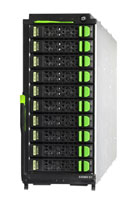Continuing with my theme from yesterday of “purpose-built” blade servers, today we take a quick look at a new offering from Fujitsu. Now, as you may have noticed, my site has traditionally been focused on blade servers from Cisco, Dell, HP and IBM but this offering from Fujitsu is so interesting, I figured I would write something up. Titled under the PRIMERGY SX label, Fujitsu’s storage blades combines Data ONTAP-vTM software from NetApp, blade hardware and an unknown hypervisor to create a “fully integrated virtual storage appliance.” The storage solution supports iSCSI, CIFS and NFS protocol and is based on Data ONTAP-vTM features such as SnapShot, FlexVol, SnapRestore and FilerView.
Titled under the PRIMERGY SX label, Fujitsu’s storage blades combines Data ONTAP-vTM software from NetApp, blade hardware and an unknown hypervisor to create a “fully integrated virtual storage appliance.” The storage solution supports iSCSI, CIFS and NFS protocol and is based on Data ONTAP-vTM features such as SnapShot, FlexVol, SnapRestore and FilerView.
The storage blades come in two flavors:
PRIMERGY SX960 S1 – a storge blade that can hold up to 10 additional hot-plug SAS or SATA HDD/SSD. These drives offer high capacity with up to 5 TB SATA HDDs, 3 TB with top-quality 2.5- inch SAS drives and up to 640 GB with power-saving 2.5-inch SATA SSDs. The only catch is that you can only fit 2 of these storage blades into a single chassis.
PRIMERGY SX940 S1 -a storge blade that can hold up to 4 additional hot-plug SAS or SATA HDD/SSD. These drives offer high capacity of up to 584 GB with high quality SAS drives, up to 2 TB with SATA HDDs .
.
I understand that Fujitsu is nearly non-existent in North America, but overseas they are well-known. As well, the purpose of this post to showcase that Fujitsu is putting NetApp’s software expertise onto a blade footprint to be used as a single purpose – to create a virtual storage array. As blade servers become more more mainstream, I expect to see more vendors team up to offer these types of integrated solutions.
For more information on Fujitsu’s servers, please visit:
http://ts.fujitsu.com/products/standard_servers/blade/bx400/storageblades.html
A special thanks to Chris Mellor for his write-up on this Fujitsu offering as seen on theregister.co.uk. Сайт знакомств
groupon houston
alcohol poisoning symptoms
endometriosis symptoms
foundation grants
strep throat contagious